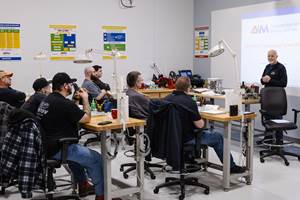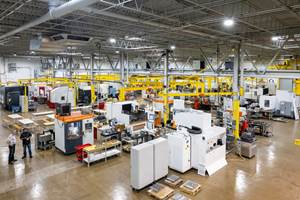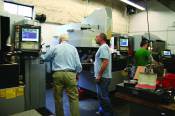Specialty Mold Design/Build Reaches New Markets
A fast-growing molding technology results in high quality and reduced production costs for molders. Learning how to design and build molds for this process can expand your capabilities.
Most mold manufacturers focus on a niche to remain successful during trying economic times. However, perhaps it is time to consider expanding your capabilities in order to be more diverse and reach more customers. Building molds that are compatible with an emerging foam injection molding and extrusion technology can be a market expander and possibly give you an edge over your competition by reducing costs to the molder, reducing part weights and in some cases, providing a tool with more cavities.
MuCell® Microcellular Foam injection molding technology is a complete process and equipment technology that enables extremely high quality parts with reduced production costs. Developed by Trexel Inc. (Woburn, MA)—which specializes in the development and commercialization of microcellular foamed processes for the plastics industry—this process introduces small, precise amounts of supercritical nitrogen gas into the molten resin during the molding process. This enables the production of otherwise unattainable stress-free parts and parts that maintain strict dimensional stability.
Process Advantages from the Moldmaker’s Perspective
Driver controls manufacturer GHSP (Hart, MI) recently began producing an automotive gear select lever for a North American OEM that utilized the MuCell process (see Photo).
The four-cavity tool was built by Grand Die Engravers (Grand Rapids, MI) and PSG Plastic Service Group (Stevensville, MI) provided the hot runner/manifold system. The development process and the production results achieved demonstrate the potential for both molders and tool builders.
“While it may look like we’re just putting plastic on the end of a rod, this is actually a critical application,” says Dave Christmas, Molding Engineering Manager for GHSP. “In operation the lever controls several functions as you go through the gear shift motion. It’s a very tight tolerance application.

Automotive gear select lever for a North American OEM. Photo courtesy of GHSP.
“We chose to go with the MuCell process for this part as we thought it would reduce costs, and give us a competitive edge in the market as well. We used to produce these types of parts using a two-cavity tool, with MuCell we were able to go to a four-cavity tool,” Christmas adds.
Jim Camfferman, VP of Grand Die Engravers (Grand Rapids, MI), notes that the MuCell learning curve for his business was straightforward, and no new investments in people, software or equipment were needed. “One big advantage with MuCell is that we were able to dramatically reduce the first trial to first part maturation process,” he states. “We hit 32 of 34 part dimensions on the first trial.”
“Any time you get into increased cavitation,” Christmas explains, “there’s going to be complexity and when you’re talking about the tight tolerances we have to deal with, it gets hard. But when we can increase cavitation from two to four, and run it with the same cycle time, and on the same size machine, that’s a huge benefit for us. I tell our customers about the process when they visit. I show them the machine with the MuCell system installed; tell them how we’ve used it and what it’s done for us. Because we have that machine on our floor we can go to four-cavity tools and be successful, and we can provide product at a lower cost and reduce part weight as well. That’s a competitive edge for us, and we think it will help us grow our business.”
Both Christmas and Camfferman believe that wherever materials with heavy glass loading will be used, OEMs and molders should be looking at the MuCell process. “From our perspective as a tool builder,” Camfferman explains, “whenever multi-cavity tools are involved, whenever dimensional stability is an issue, where there are tight tolerances, or wherever materials with heavy glass loading will be used, MuCell is a good way to go. We now know how to build MuCell tools and we’re going to tell our customers where they can take advantage of this technology.”
Here is what you need to know to build a MuCell mold.
Mold Design/Build Considerations
According to Levi Kishbaugh, Trexel’s Vice President, Injection Molding, VP, Injection Molding, there are several areas that need to be considered when designing and building a mold in MuCell.
Hot Runner
“First and foremost, if a customer is working with a hot runner system, it needs to be valve gated,” Kishbaugh points out. “The valve gates have to withstand a static load of 3,500 psi.” Additionally, he notes that the hot runners need to be naturally flow balanced, and individual control of the valve gates provides the best control (Visit Specialty Mold Design/Build Reaches New Markets for more details on Hot Runner Considerations with an Injection Mold with MuCell).
Venting
Venting is another area of concern because it is important not to create a counterpressure situation that will hinder gas expansion, Kishbaugh maintains. “You have to make sure you have very free and easy venting on the mold cavities,” he states. “We will run typically at a 50 percent deeper vent depth than you would on a normal mold. Case in point: if you are running a material that you would typically have 1½ thousandths vent depth, we would maybe look at 2¼. Since there is probably half the cavity pressure, we're not worried about pushing plastic into those vents. But, we are worried about getting the gas out.”
Cooling
“The issue with MuCell is hot spots in the part,” Kishbaugh adds. “When the mold opens, if the material does not have a sufficient strength in the skin, internally you still have this expansion capability and it wants to expand after you open the mold—and the hot spots in the mold are more susceptible to that. We need to make sure we get cooling to areas that would traditionally be hot spots in a mold.” This can involve the use of higher thermal conductivity metals as well as thermal pins.
Applications/Limitations
MuCell’s two biggest markets are non-visible automotive applications and non-visible applications in the printer (chassis, etc.) market, Kishbaugh notes. Trexel would like to delve into more visual applications—particularly in the printer market—but it is difficult because the process does not leave parts with a high gloss finish. “We are working with some material suppliers to develop some new resins particularly with glass-filled PA6 and 6.6,” he states.
Collaborate/Communicate
Kishbaugh emphasizes the importance of front-end collaboration between all parties. “Often the first time a moldmaker will hear about MuCell is if one of their customers requests it,” he notes. “They should give us a call and we’d be happy to work through the process with them.”
The MuCell process affords today’s mold manufacturer the opportunity to expand capabilities—thus reaching new markets—without having to invest in manpower, software or equipment. Following the steps outlined can lead to a successful venture.
Related Content
Mold Maintenance Continues to Matter: Enhanced Training Program in a New Facility
I attended a MoldTrax mold maintenance workshop in 2019 and shared my experiences, and despite changes in ownership, the workshop's remarkable value endures, as discussed in a recent Q&A with the current leadership.
Read MoreCross Training, In-House Capabilities and Collaborative Design Move Helm Tool Forward
Cross-training, bringing it all in-house, molding and collaborative design are essential to Helm Tool's success.
Read MoreDynamic Tool Corporation – Creating the Team to Move Moldmaking Into the Future
For 40+ years, Dynamic Tool Corp. has offered precision tooling, emphasizing education, mentoring and innovation. The company is committed to excellence, integrity, safety and customer service, as well as inspiring growth and quality in manufacturing.
Read MoreHow to Foster Innovation Through a Culture of Education, Mentoring
Dynamic Tool Corp. shares its strategy for building a team with the right attitude and aptitude to deliver innovation that meets customer expectations.
Read MoreRead Next
LSR/LIM Molding: A Unique Niche
One moldmaker’s decision to venture into liquid silicone rubber/liquid injection molding makes it one of the few shops that can provide molds for liquid silicone.
Read MoreAre You a Moldmaker Considering 3D Printing? Consider the 3D Printing Workshop at NPE2024
Presentations will cover 3D printing for mold tooling, material innovation, product development, bridge production and full-scale, high-volume additive manufacturing.
Read MoreHow to Use Continuing Education to Remain Competitive in Moldmaking
Continued training helps moldmakers make tooling decisions and properly use the latest cutting tool to efficiently machine high-quality molds.
Read More




















